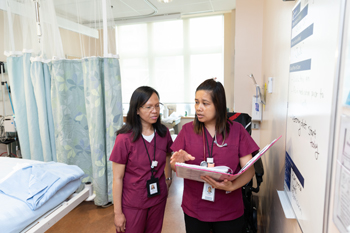Listening to patients

Reimagining patient education by building better tools to improve health literacy
By Emily Dawson

Nurses Honeylet Rivera (left) and Ranjeeta Rungta (right) discuss what to add to a patient’s whiteboard. (Photo by Yuri Markarov)
Aug. 26, 2019 – Registered nurses Katherine Mansfield and Sarah Kreher never would’ve thought that bedside whiteboards could dramatically affect the care experience until they heard it directly from patients.
Research suggests that low health literacy is associated with lower adherence to medication, poor chronic disease management, and increased hospitalization.
In response, the Patient and Family Education program at Unity Health Toronto created workshops and courses that help staff, physicians, and learners develop more impactful patient education strategies and resources.
“Many patients have difficulty understanding or remembering information provided by health care providers. We’re trying to bridge these gaps,” said Katrina Grieve, a patient education specialist in St. Michael’s Patient and Family Education program.
Community of Practice sessions provide a forum to hear directly from patients and families and share ideas. Kreher, Mansfield and clinical leader manager Joanne Bennett say patient voices have left a lasting impression on their work.
On St. Michael’s general surgery unit, each bed has a whiteboard that should be – but isn’t always – updated daily with information like how the patient is feeling, what they prefer to be called, and names of their care team members. Bennett and Mansfield were surprised to hear that patients feel demoralized when staff don’t take time to update the whiteboards. “One patient told me he ‘feels like he matters’ when clinicians incorporate information from the board into his plan of care,” said Bennett.
In St. Joseph’s renal outpatient clinic, dietitian Fiona Bellefeuille cares for patients who live with chronic illness. She recently attended a session on developing patient videos to help people with disease management. “Our clinic patients on hemodialysis sit in chairs for four hours and each chair has a TV,” said Bellefeuille. “Simple, visual materials are so effective and transcend barriers.”
For Valerie McWhinnie, a physiotherapist at Providence, one of her most valuable learnings was about the teach-back technique – an approach to teach or present complex information by breaking it down into simple pieces and having patients repeat in their own words what they just learned.
“I now ask patients ‘can you tell me what you understand?’ You may think you’ve given great information but you don’t always know what they’ve absorbed,” said McWhinnie.
